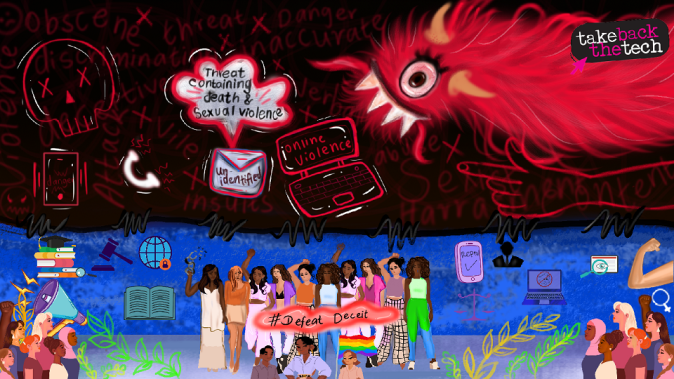Gendered Disinformation 101: When gender is the locus. #DefeatDeceit

Online gender-based violence (OGBV) is now a widely accepted term used to name the behaviours that harass and target women and gender-marginalised people on the internet. A much lesser known term — a subset of OGBV — is gendered disinformation, an evergrowing concern today.
So what is gendered disinformation?
Gendered disinformation is a strategy to silence women and queer folks that “uses false or misleading gender and sex-based narratives against women, often with some degree of coordination”, and aims to stop women and queer (human rights defenders) from taking part in digital publics.
Not only does it combine falsity, coordination and malign intent — the three defining characteristics of disinformation — it is gendered because:
- It targets women and gender-diverse folks.
- It uses gendered stereotypes and beliefs in its attacks.
- It reinforces prejudices and barriers against gender justice.
It uses threats of violence, gendered shaming (through double standards around sexuality and gendered biases) and intimidation as three common tactics that often overlap with each other.
Misogyny has always been an issue and a weapon used to push women and marginalised persons outside of public spaces. Today, it is amplified on digital spaces with the internet’s reach and newer tools.
‘Monetising Misogny’, a study done over two years and published by #ShePersisted, went into the "how’s and why’s" of gendered disinformation in several countries. The research provided insights into these questions and some answers — according to the study, “the problem lies less in the misogyny per se than in its weaponisation by dark actors — and monetisation by digital platforms.”
In the research, dozens of women leaders and experts from Hungary, India, Brazil, Italy and Tunisia were interviewed. A large number of horrific social media posts against them was analysed, and gendered disinformation campaigns were systematically documented. Although hate, threats and abuse are visible as tools within gendered disinformation narratives as strategic attacks, it goes further than that.
Gendered disinformation most visibly targets outspoken women and queer persons who espouse progressive policies and beliefs. Fake stories, morphed photos, and threats to their families are common, and the barrage discourages women from speaking out and silences their free expression.
Gendered disinformation is a strategic way autocratic and illiberal forces silence women and queer persons who speak against them, and the free expression of other women who see this taking place digitally. It undermines the functioning of a free and fair democracy.
For example, here’s a story: In 2021, Annalena Baerbock — a German politician — experienced a huge increase in popularity ahead of the 2021 September chancellery elections. However, after pledging to block a gas pipeline project between Russia and Europe, she quickly became the target of a vicious digital campaign.
Morphed images of a nude Russian model were circulated with Baerbock as the focus and a suggestion that she was a sex worker before becoming a politician. As this narrative spread, sexist attacks followed, “including questions about whether she could balance the responsibilities of chancellorship with being a mother. Her high approval rate quickly plummeted and Baerbock eventually lost the election, coming in third place.”
Such stories are commonplace around the world as gendered disinformation is used as a popular, effective and strategic tactic to silence progressive women and queer persons. It is most striking when women are in leadership positions or in the public eye, and in electoral democracies — this highly emotive tool leads to backsliding of rights and terrifying consequences for those targeted, including death (such as Jo Cox, a British MP who was murdered by a far-right activist after having been targeted by gendered disinformation).
Marginalised women are attacked more, on the basis of their gender as well as its intersection with their other identities. For example, Angellica Aribam, a woman from Manipur in India, said that the disinformation she faced was “far worse because of a perception that women from the northeast region of India are “easy” and “characterless.”
Di Meco, the author of ‘Monetising Misogyny’ says this happens because often, “just by the fact of being themselves, these women represent a goal of inclusive democracies, democracies that are multicultural or multi-religious.”
Added to this, Big Tech and social media platforms are failing to protect women from OGBV and gendered disinformation. Algorithms are primed to share disinformation as it prioritises profits for companies over the rights and well-being of people, and harmful narratives against women and queer persons become viral at the expense of civic and personal health.
Trending topics, recommender systems, coordinated sharing tools and no real response to “coordinated inauthentic behaviour” worldwide, especially when led by politicians, have exacerbated the problem to a great degree.
Although some initiatives and research (for example, around digital literacy) are being funded by platforms, it has not helped much — and is mostly “cosmetic”, as Di Meco says.
Artist: Imaan Jufeer
Image description: A group of diverse women in the center, surrounded by ways of disseminating information, displaying resistance and greenery. Above them is the threat of gendered disinformation, signified by a red monster and online gender-based violence popping up on a laptop and threats of violence. A banner in the midst of the group says "#DefeatDeceit".
- Log in to post comments
